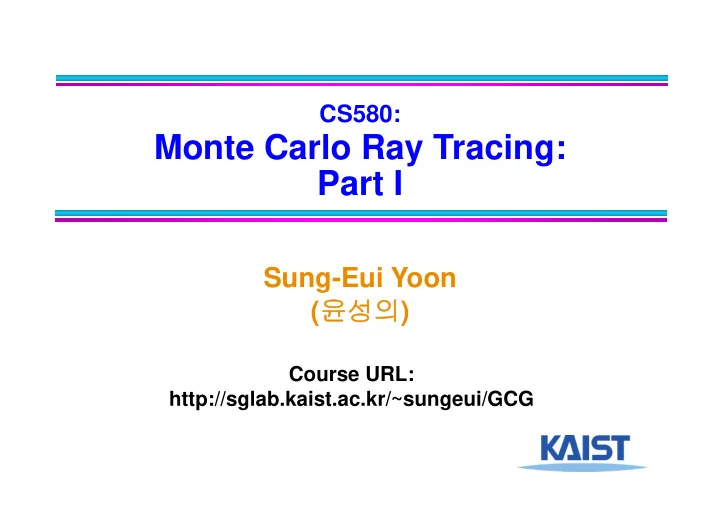

CS580: Monte Carlo Ray Tracing: Part I Sung-Eui Yoon ( 윤성의 ) Course URL: http://sglab.kaist.ac.kr/~sungeui/GCG
Class Objectives ● Understand a basic structure of Monte Carlo ray tracing ● Russian roulette for its termination ● Stratified sampling ● Quasi-Monte Carlo ray tracing 2
Why Monte Carlo? ● Radiace is hard to evaluate From kavita’s slides ● Sample many paths ● Integrate over all incoming directions ● Analytical integration is difficult ● Need numerical techniques 3
4
5
How to compute? ● Use Monte Carlo ● Generate random directions on hemisphere Ω X using pdf p( Ψ ) 6
7
8
9
When to end recursion? From kavita’s slides ● Contributions of further light bounces become less significant ● Max recursion ● Some threshold for radiance value ● If we just ignore them, estimators will be biased 10
11
Russian Roulette ● Pick absorption probability, α = 1-P ● Recursion is terminated ● 1- α is commonly to be equal to the reflectance of the material of the surface ● Darker surface absorbs more paths 12
Algorithm so far ● Shoot primary rays through each pixel ● Shoot indirect rays, sampled over hemisphere ● Terminate recursion using Russian Roulette 13
Pixel Anti-Aliasing ● Compute radiance only at the center of pixel ● Produce jaggies ● Simple box filter ● The averaging method ● We want to evaluate using MC 14
Stochastic Ray Tracing ● Parameters ● Num. of starting ray per pixel ● Num. of random rays for each surface point (branching factor) ● Path tracing ● Branching factor = 1 15
Path Tracing From kavita’s slides ● Pixel sampling + light source sampling folded into one method 16
Algorithm so far ● Shoot primary rays through each pixel ● Shoot indirect rays, sampled over hemisphere ● Path tracing shoots only 1 indirect ray ● Terminate recursion using Russian Roulette 17
Algorithm 18
Performance ● Want better quality with smaller # of samples ● Fewer samples/better performance ● Stratified sampling ● Quasi Monte Carlo: well-distributed samples ● Faster convergence ● Importance sampling 19
PA2 Uniform sampling Adaptive sampling Reference (64 samples per pixel) 20
21
22
23
High Dimensions ● Problem for higher dimensions ● Sample points can still be arbitrarily close to each other 24
Higher Dimensions ● Stratified grid sampling ● N-rooks sampling 25
26
27
28
29
Example: van der Corput Sequence ● One of simplest low-discrepancy sequences ● Radical inverse function, Φ b (n) ● Given n = , i 1 d i b i 1 ● Φ b (n) = 0.d 1 d 2 d 3 … d n ● E.g., Φ 2 (i): 111010 2 0.010111 ● van der Corput sequence, x i = Φ 2 (i) 30
Example: van der Corput Sequence ● One of simplest low-discrepancy sequences ● x i = Φ 2 (i) i Base 2 Φ 2 (i) 1 1 .1 = 1/2 2 10 .01 = 1/4 3 11 .11 = 3/4 4 100 .001 = 1/8 5 101 .101 = 5/8 . . . . . . . . . 31
Halton and Hammersley ● Halton ● x i =( Φ 2 (i), Φ 3 (i), Φ 5 (i), …, Φ prime (i)) ● Hammersley ● x i =(1/N, Φ 2 (i), Φ 3 (i), Φ 5 (i), …, Φ prime (i)) ● Assume we know the number of samples, N ● Has slightly lower discrepancy Halton Hammersley 32
Why Use Quasi Monte Carlo? ● No randomness ● Much better than pure Monte Carlo method ● Converge as fast as stratified sampling 33
Performance and Error ● Want better quality with smaller number of samples ● Fewer samples better performance ● Stratified sampling ● Quasi Monte Carlo: well-distributed samples ● Faster convergence ● Importance sampling: next-event estimation 34
Class Objectives were: ● Understand a basic structure of Monte Carlo ray tracing ● Russian roulette for its termination ● Stratified sampling ● Quasi-Monte Carlo ray tracing 35
Recommend
More recommend